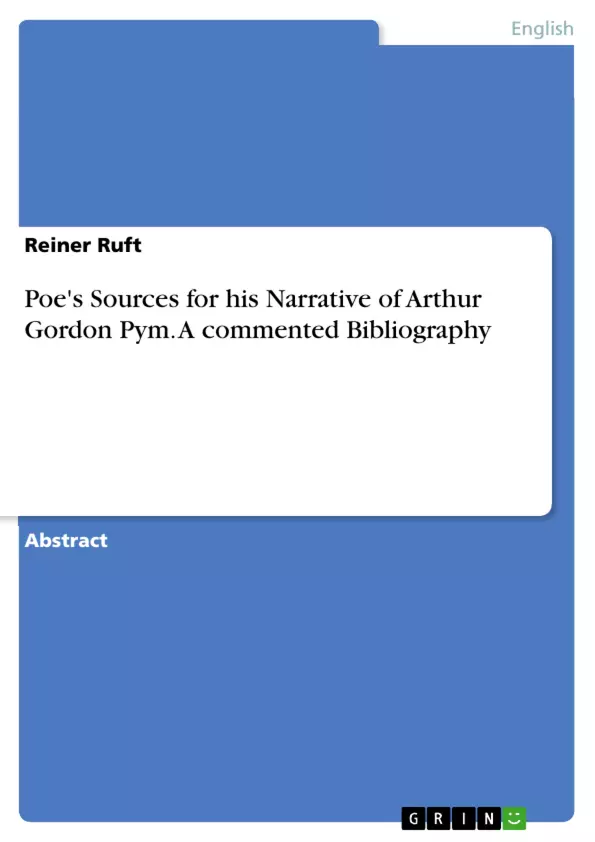This commented bibliography asks for the origin of Edgar Allan Poe's idea of the hollow earth which he describes in his only novel: "Narrative of Arthur Gordon Pym". It's subdivided in four parts: 1. Related material in Poe's own writing, 2. Poe's indebtedness to previous literature, 3. Poe's sources for the maritime occurrences, descriptions of islands, accounts of previous voyages of discovery in Arthur Gordon Pym, 4. Poe's sources for the events on Tsalal, especially the black-white antagonism, and for the South Pole cataract.
Inhaltsverzeichnis (Table of Contents)
- I. Related material in Poe's own writing.
- II. Poe's indebtedness to previous literature.
- III. Poe's sources for the maritime occurrences, descriptions of islands, accounts of previous voyages of discovery in A.G.Pym
- IV. Poe's sources for the events on Tsalal, especially the black-white antagonism, and for the South Pole cataract.
Zielsetzung und Themenschwerpunkte (Objectives and Key Themes)
This text aims to explore the literary influences and sources that shaped Edgar Allan Poe's famous narrative, "The Narrative of Arthur Gordon Pym." The author meticulously investigates Poe's borrowing from earlier works, including maritime accounts, fictional voyages, and philosophical theories, in order to provide a comprehensive understanding of the text's construction and its relationship to other works of literature.
- Poe's borrowing from previous literature
- Exploration of maritime occurrences and descriptions of islands
- Analysis of Poe's sources for the events on Tsalal, particularly the black-white antagonism
- Examination of the influence of Captain John Cleve Symmes's theory of the hollow earth
- Interpretation of Poe's work in light of his own literary criticism
Zusammenfassung der Kapitel (Chapter Summaries)
- I. Related material in Poe's own writing: This chapter examines Poe's earlier stories, "MS. Found in a Bottle" and "The Unparalleled Adventure of one Hans Pfaall," highlighting elements that foreshadow or relate to the themes and imagery found in "Arthur Gordon Pym." Notably, both stories feature a focus on maritime adventure and elements of the South Pole.
- II. Poe's indebtedness to previous literature: This chapter explores Poe's literary influences, citing works by renowned authors like Coleridge, Swift, Defoe, and Voltaire, and emphasizing Poe's extensive reading background.
- III. Poe's sources for the maritime occurrences, descriptions of islands, accounts of previous voyages of discovery in A.G.Pym: This chapter delves into the specific sources Poe used for the maritime aspects of "Arthur Gordon Pym," analyzing his use of works by Captain Benjamin Morrell, J.N. Reynolds, and Archibald Duncan, among others. It reveals how Poe incorporated real-life accounts of voyages, shipwrecks, and descriptions of exotic locales into his fictional narrative.
- IV. Poe's sources for the events on Tsalal, especially the black-white antagonism, and for the South Pole cataract: This chapter investigates the sources for the final portion of the story, focusing on the enigmatic island of Tsalal and its inhabitants. The author explores Poe's potential reliance on John L. Stephens's work on Arabia Petraea, theories of a hollow earth, and the writings of Voltaire to interpret the symbolism and themes present in the text.
Schlüsselwörter (Keywords)
This work analyzes the literary sources of Edgar Allan Poe's "The Narrative of Arthur Gordon Pym," focusing on themes of maritime adventure, exploration, the unknown, and the influence of earlier literary works. It delves into specific sources such as accounts of voyages of discovery, fictional narratives, and philosophical theories, including Captain John Cleve Symmes's theory of the hollow earth and Voltaire's writings.
- Quote paper
- Reiner Ruft (Author), 1973, Poe's Sources for his Narrative of Arthur Gordon Pym. A commented Bibliography, Munich, GRIN Verlag, https://www.grin.com/document/511394



